Exploring Child Abuse Prevalence and Disclosure Dynamics
VerifiedAdded on 2020/05/28
|65
|17941
|37
AI Summary
The presented studies collectively aim to understand the prevalence, patterns, and impacts of different forms of child abuse while examining the processes of disclosure. Chan et al. (2013) focus on China's demographic influences on child abuse rates, finding significant effects from gender and parental unemployment. Jackson, Browne, and Joseph (2016) highlight high incidences of victimization among UK youth, including bullying and physical abuse. Radford et al. (2013) provide national estimates in a UK context, identifying alarming levels of sexual victimization. Finkelhor et al. (2014) extend this scope to national data, revealing that 12.1% of surveyed children experienced some form of maltreatment. Schönbucher et al. (2012) and Schaeffer, Leventhal, & Asnes (2011) investigate factors affecting disclosure among adolescents, noting barriers like fear and threats from perpetrators. McElvaney, Green, & Hogan (2012) model the process of abuse disclosure to parents, identifying key psychological dynamics. Mahram et al. (2013) focus on specific types of abuse such as psychological maltreatment, while Cyr et al. (2013) address polyvictimisation, revealing that a significant portion of participants have faced multiple forms of victimization.
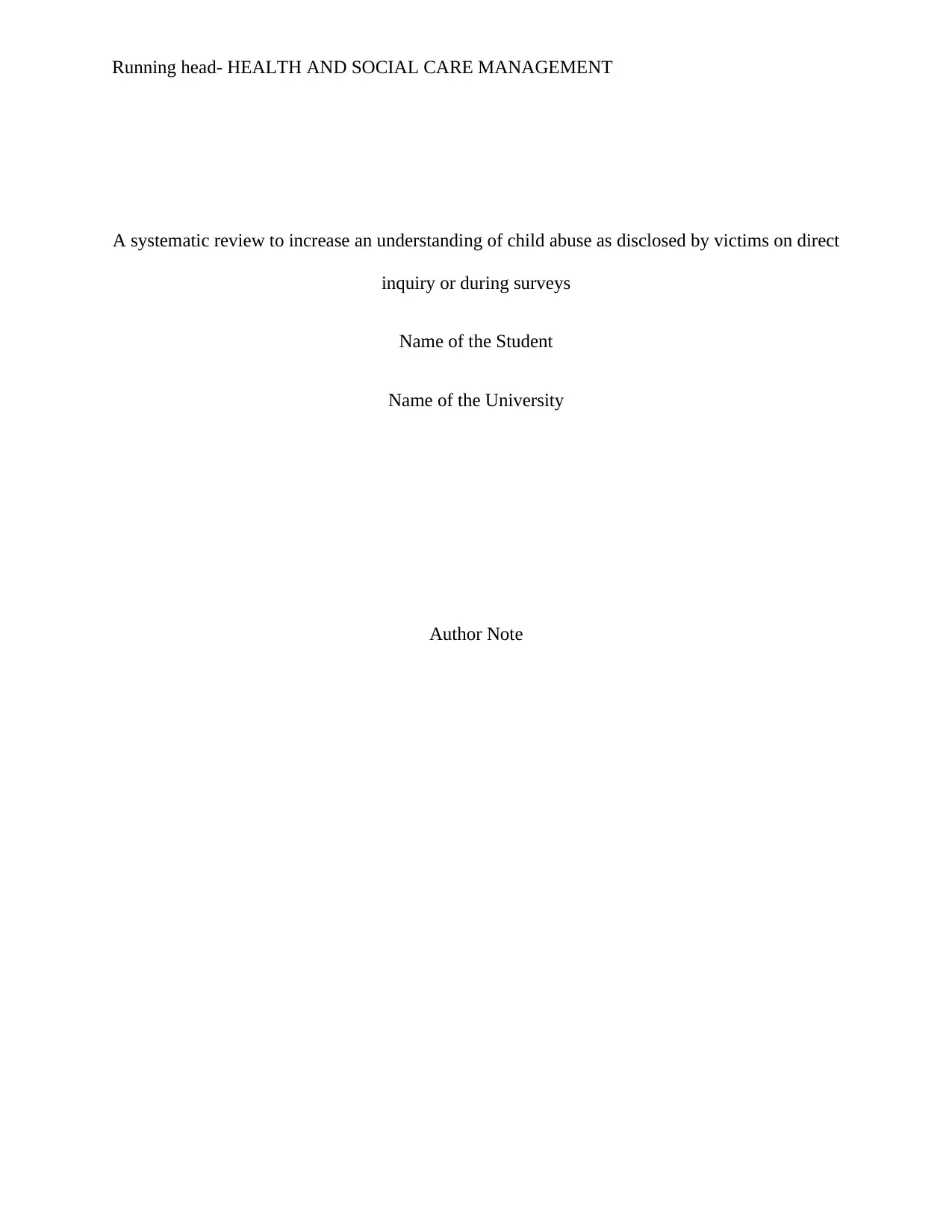
Running head- HEALTH AND SOCIAL CARE MANAGEMENT
A systematic review to increase an understanding of child abuse as disclosed by victims on direct
inquiry or during surveys
Name of the Student
Name of the University
Author Note
A systematic review to increase an understanding of child abuse as disclosed by victims on direct
inquiry or during surveys
Name of the Student
Name of the University
Author Note
Paraphrase This Document
Need a fresh take? Get an instant paraphrase of this document with our AI Paraphraser
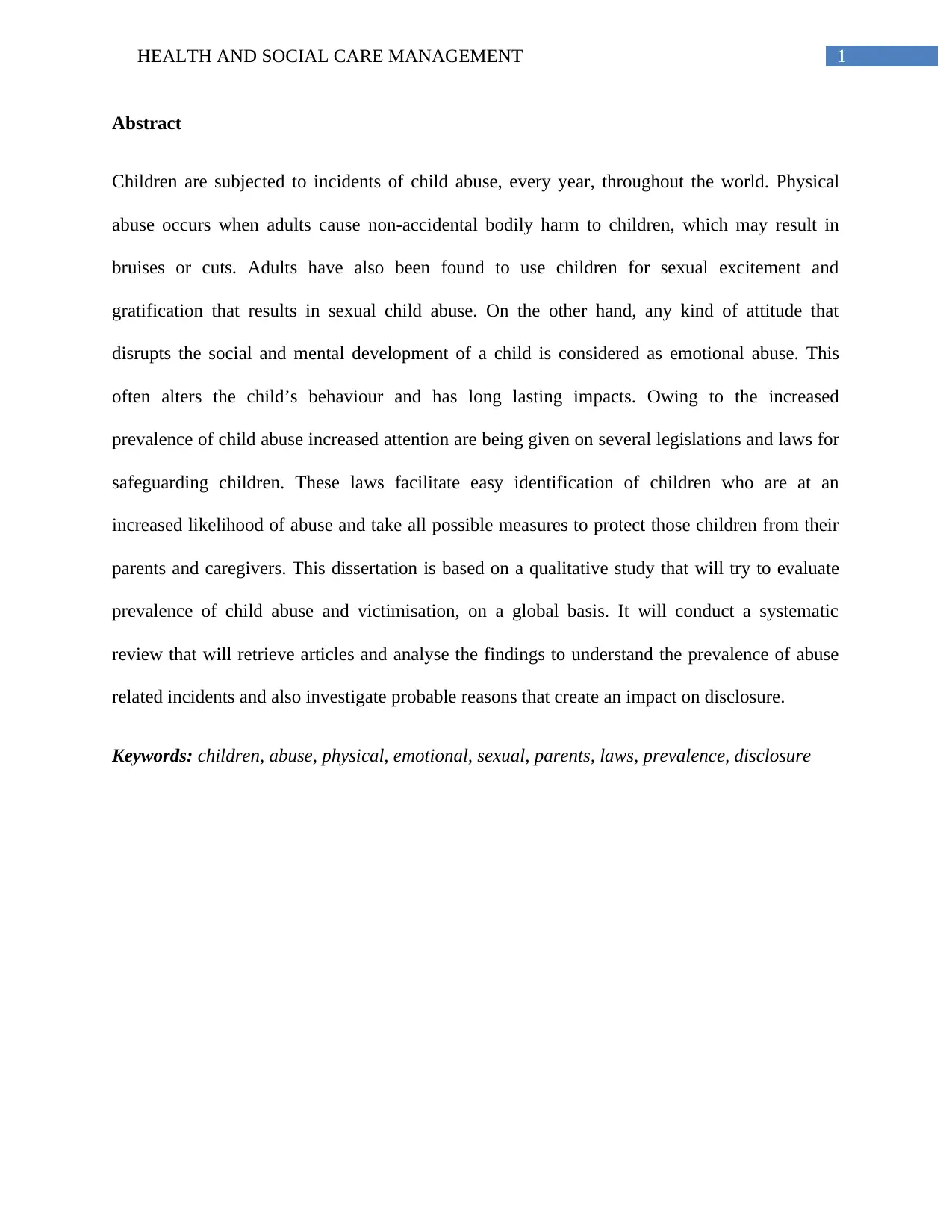
1HEALTH AND SOCIAL CARE MANAGEMENT
Abstract
Children are subjected to incidents of child abuse, every year, throughout the world. Physical
abuse occurs when adults cause non-accidental bodily harm to children, which may result in
bruises or cuts. Adults have also been found to use children for sexual excitement and
gratification that results in sexual child abuse. On the other hand, any kind of attitude that
disrupts the social and mental development of a child is considered as emotional abuse. This
often alters the child’s behaviour and has long lasting impacts. Owing to the increased
prevalence of child abuse increased attention are being given on several legislations and laws for
safeguarding children. These laws facilitate easy identification of children who are at an
increased likelihood of abuse and take all possible measures to protect those children from their
parents and caregivers. This dissertation is based on a qualitative study that will try to evaluate
prevalence of child abuse and victimisation, on a global basis. It will conduct a systematic
review that will retrieve articles and analyse the findings to understand the prevalence of abuse
related incidents and also investigate probable reasons that create an impact on disclosure.
Keywords: children, abuse, physical, emotional, sexual, parents, laws, prevalence, disclosure
Abstract
Children are subjected to incidents of child abuse, every year, throughout the world. Physical
abuse occurs when adults cause non-accidental bodily harm to children, which may result in
bruises or cuts. Adults have also been found to use children for sexual excitement and
gratification that results in sexual child abuse. On the other hand, any kind of attitude that
disrupts the social and mental development of a child is considered as emotional abuse. This
often alters the child’s behaviour and has long lasting impacts. Owing to the increased
prevalence of child abuse increased attention are being given on several legislations and laws for
safeguarding children. These laws facilitate easy identification of children who are at an
increased likelihood of abuse and take all possible measures to protect those children from their
parents and caregivers. This dissertation is based on a qualitative study that will try to evaluate
prevalence of child abuse and victimisation, on a global basis. It will conduct a systematic
review that will retrieve articles and analyse the findings to understand the prevalence of abuse
related incidents and also investigate probable reasons that create an impact on disclosure.
Keywords: children, abuse, physical, emotional, sexual, parents, laws, prevalence, disclosure
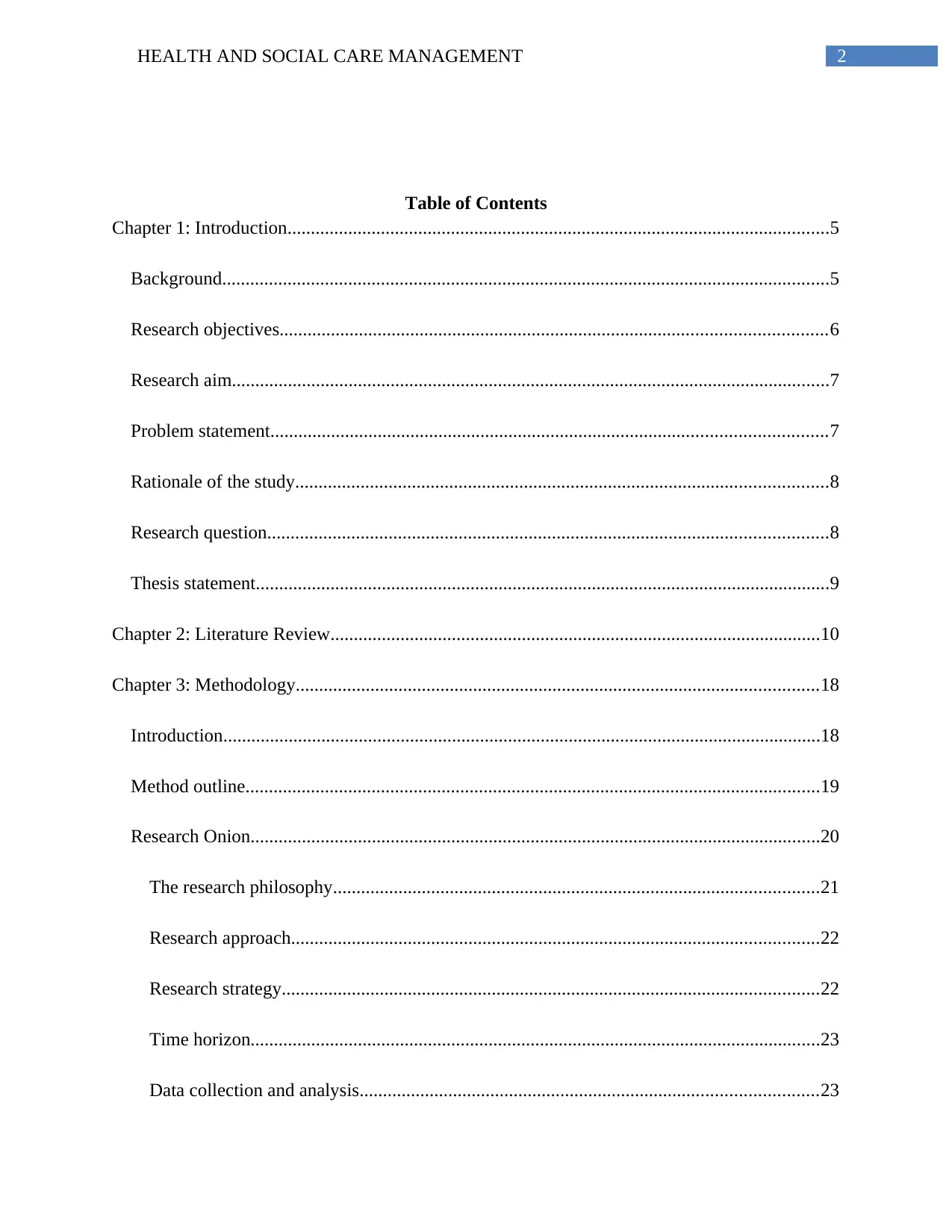
2HEALTH AND SOCIAL CARE MANAGEMENT
Table of Contents
Chapter 1: Introduction....................................................................................................................5
Background..................................................................................................................................5
Research objectives.....................................................................................................................6
Research aim................................................................................................................................7
Problem statement.......................................................................................................................7
Rationale of the study..................................................................................................................8
Research question........................................................................................................................8
Thesis statement...........................................................................................................................9
Chapter 2: Literature Review.........................................................................................................10
Chapter 3: Methodology................................................................................................................18
Introduction................................................................................................................................18
Method outline...........................................................................................................................19
Research Onion..........................................................................................................................20
The research philosophy........................................................................................................21
Research approach.................................................................................................................22
Research strategy...................................................................................................................22
Time horizon..........................................................................................................................23
Data collection and analysis..................................................................................................23
Table of Contents
Chapter 1: Introduction....................................................................................................................5
Background..................................................................................................................................5
Research objectives.....................................................................................................................6
Research aim................................................................................................................................7
Problem statement.......................................................................................................................7
Rationale of the study..................................................................................................................8
Research question........................................................................................................................8
Thesis statement...........................................................................................................................9
Chapter 2: Literature Review.........................................................................................................10
Chapter 3: Methodology................................................................................................................18
Introduction................................................................................................................................18
Method outline...........................................................................................................................19
Research Onion..........................................................................................................................20
The research philosophy........................................................................................................21
Research approach.................................................................................................................22
Research strategy...................................................................................................................22
Time horizon..........................................................................................................................23
Data collection and analysis..................................................................................................23
⊘ This is a preview!⊘
Do you want full access?
Subscribe today to unlock all pages.

Trusted by 1+ million students worldwide
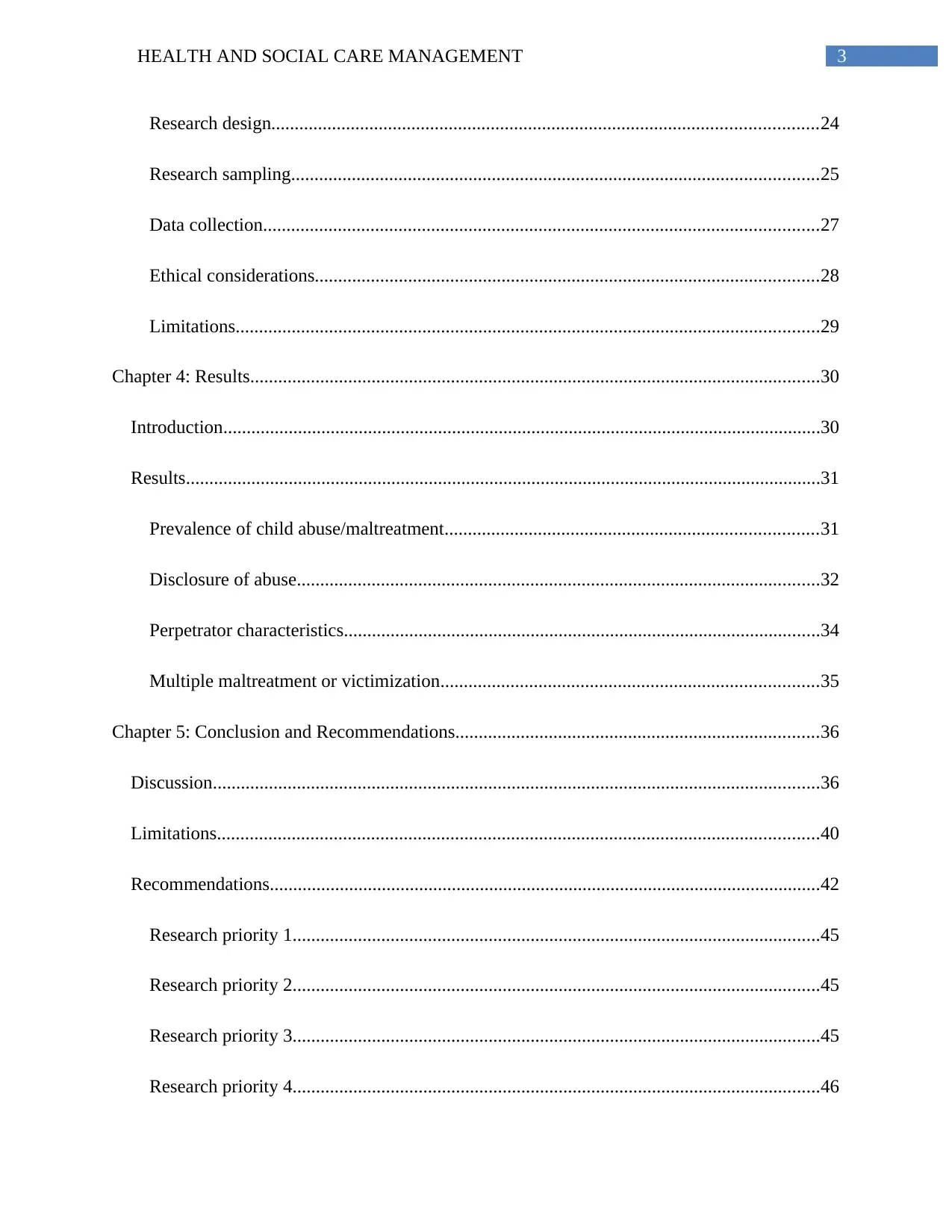
3HEALTH AND SOCIAL CARE MANAGEMENT
Research design.....................................................................................................................24
Research sampling.................................................................................................................25
Data collection.......................................................................................................................27
Ethical considerations............................................................................................................28
Limitations.............................................................................................................................29
Chapter 4: Results..........................................................................................................................30
Introduction................................................................................................................................30
Results........................................................................................................................................31
Prevalence of child abuse/maltreatment................................................................................31
Disclosure of abuse................................................................................................................32
Perpetrator characteristics......................................................................................................34
Multiple maltreatment or victimization.................................................................................35
Chapter 5: Conclusion and Recommendations..............................................................................36
Discussion..................................................................................................................................36
Limitations.................................................................................................................................40
Recommendations......................................................................................................................42
Research priority 1.................................................................................................................45
Research priority 2.................................................................................................................45
Research priority 3.................................................................................................................45
Research priority 4.................................................................................................................46
Research design.....................................................................................................................24
Research sampling.................................................................................................................25
Data collection.......................................................................................................................27
Ethical considerations............................................................................................................28
Limitations.............................................................................................................................29
Chapter 4: Results..........................................................................................................................30
Introduction................................................................................................................................30
Results........................................................................................................................................31
Prevalence of child abuse/maltreatment................................................................................31
Disclosure of abuse................................................................................................................32
Perpetrator characteristics......................................................................................................34
Multiple maltreatment or victimization.................................................................................35
Chapter 5: Conclusion and Recommendations..............................................................................36
Discussion..................................................................................................................................36
Limitations.................................................................................................................................40
Recommendations......................................................................................................................42
Research priority 1.................................................................................................................45
Research priority 2.................................................................................................................45
Research priority 3.................................................................................................................45
Research priority 4.................................................................................................................46
Paraphrase This Document
Need a fresh take? Get an instant paraphrase of this document with our AI Paraphraser
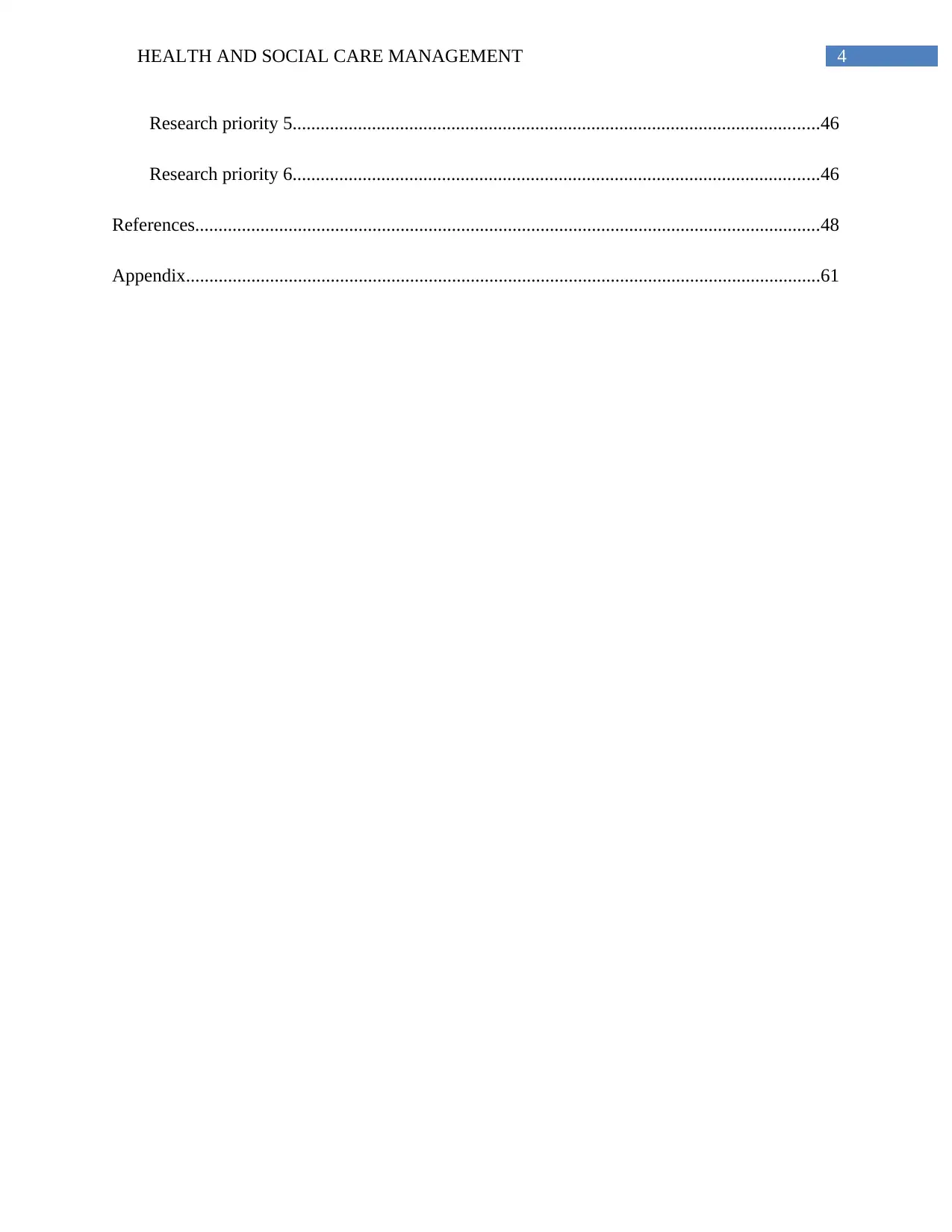
4HEALTH AND SOCIAL CARE MANAGEMENT
Research priority 5.................................................................................................................46
Research priority 6.................................................................................................................46
References......................................................................................................................................48
Appendix........................................................................................................................................61
Research priority 5.................................................................................................................46
Research priority 6.................................................................................................................46
References......................................................................................................................................48
Appendix........................................................................................................................................61
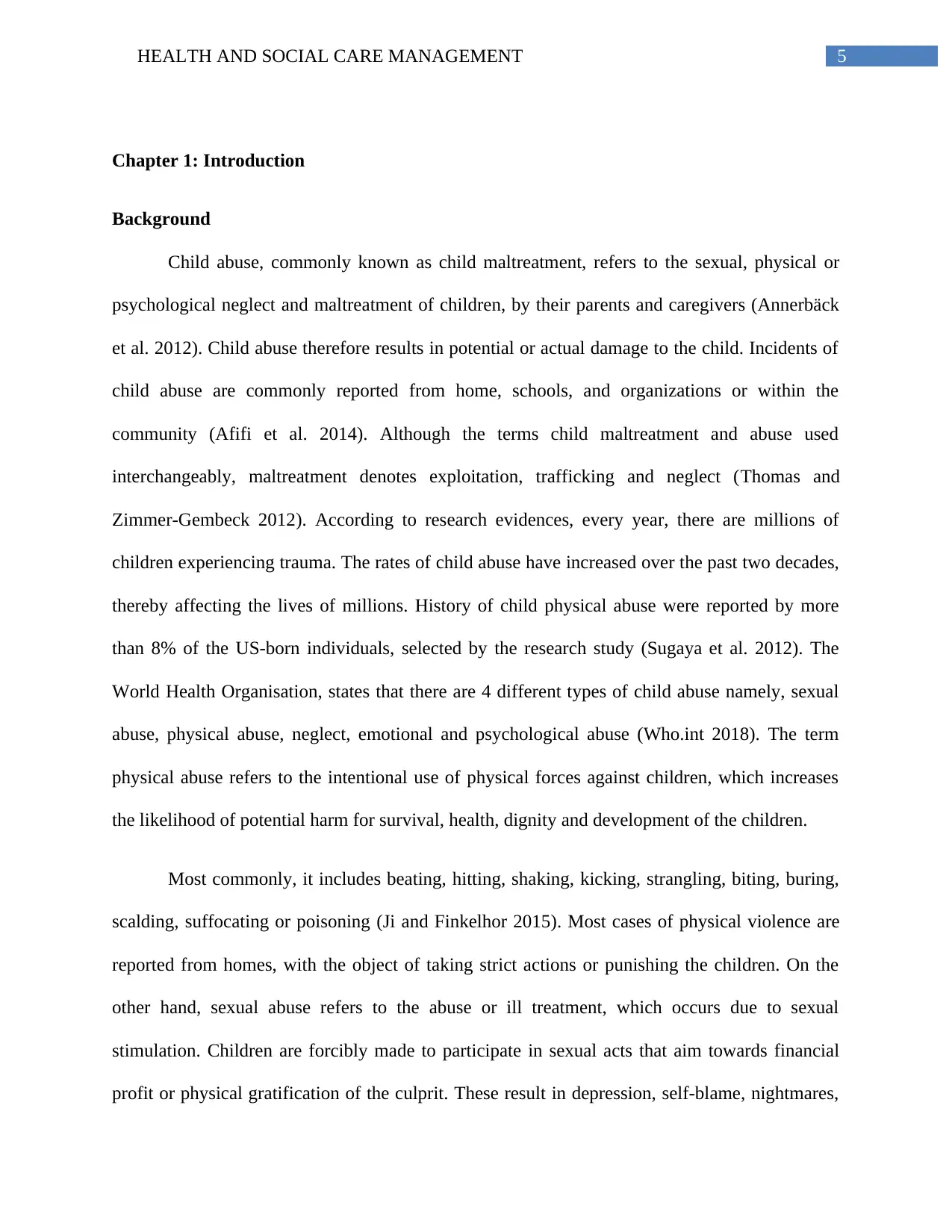
5HEALTH AND SOCIAL CARE MANAGEMENT
Chapter 1: Introduction
Background
Child abuse, commonly known as child maltreatment, refers to the sexual, physical or
psychological neglect and maltreatment of children, by their parents and caregivers (Annerbäck
et al. 2012). Child abuse therefore results in potential or actual damage to the child. Incidents of
child abuse are commonly reported from home, schools, and organizations or within the
community (Afifi et al. 2014). Although the terms child maltreatment and abuse used
interchangeably, maltreatment denotes exploitation, trafficking and neglect (Thomas and
Zimmer-Gembeck 2012). According to research evidences, every year, there are millions of
children experiencing trauma. The rates of child abuse have increased over the past two decades,
thereby affecting the lives of millions. History of child physical abuse were reported by more
than 8% of the US-born individuals, selected by the research study (Sugaya et al. 2012). The
World Health Organisation, states that there are 4 different types of child abuse namely, sexual
abuse, physical abuse, neglect, emotional and psychological abuse (Who.int 2018). The term
physical abuse refers to the intentional use of physical forces against children, which increases
the likelihood of potential harm for survival, health, dignity and development of the children.
Most commonly, it includes beating, hitting, shaking, kicking, strangling, biting, buring,
scalding, suffocating or poisoning (Ji and Finkelhor 2015). Most cases of physical violence are
reported from homes, with the object of taking strict actions or punishing the children. On the
other hand, sexual abuse refers to the abuse or ill treatment, which occurs due to sexual
stimulation. Children are forcibly made to participate in sexual acts that aim towards financial
profit or physical gratification of the culprit. These result in depression, self-blame, nightmares,
Chapter 1: Introduction
Background
Child abuse, commonly known as child maltreatment, refers to the sexual, physical or
psychological neglect and maltreatment of children, by their parents and caregivers (Annerbäck
et al. 2012). Child abuse therefore results in potential or actual damage to the child. Incidents of
child abuse are commonly reported from home, schools, and organizations or within the
community (Afifi et al. 2014). Although the terms child maltreatment and abuse used
interchangeably, maltreatment denotes exploitation, trafficking and neglect (Thomas and
Zimmer-Gembeck 2012). According to research evidences, every year, there are millions of
children experiencing trauma. The rates of child abuse have increased over the past two decades,
thereby affecting the lives of millions. History of child physical abuse were reported by more
than 8% of the US-born individuals, selected by the research study (Sugaya et al. 2012). The
World Health Organisation, states that there are 4 different types of child abuse namely, sexual
abuse, physical abuse, neglect, emotional and psychological abuse (Who.int 2018). The term
physical abuse refers to the intentional use of physical forces against children, which increases
the likelihood of potential harm for survival, health, dignity and development of the children.
Most commonly, it includes beating, hitting, shaking, kicking, strangling, biting, buring,
scalding, suffocating or poisoning (Ji and Finkelhor 2015). Most cases of physical violence are
reported from homes, with the object of taking strict actions or punishing the children. On the
other hand, sexual abuse refers to the abuse or ill treatment, which occurs due to sexual
stimulation. Children are forcibly made to participate in sexual acts that aim towards financial
profit or physical gratification of the culprit. These result in depression, self-blame, nightmares,
⊘ This is a preview!⊘
Do you want full access?
Subscribe today to unlock all pages.

Trusted by 1+ million students worldwide
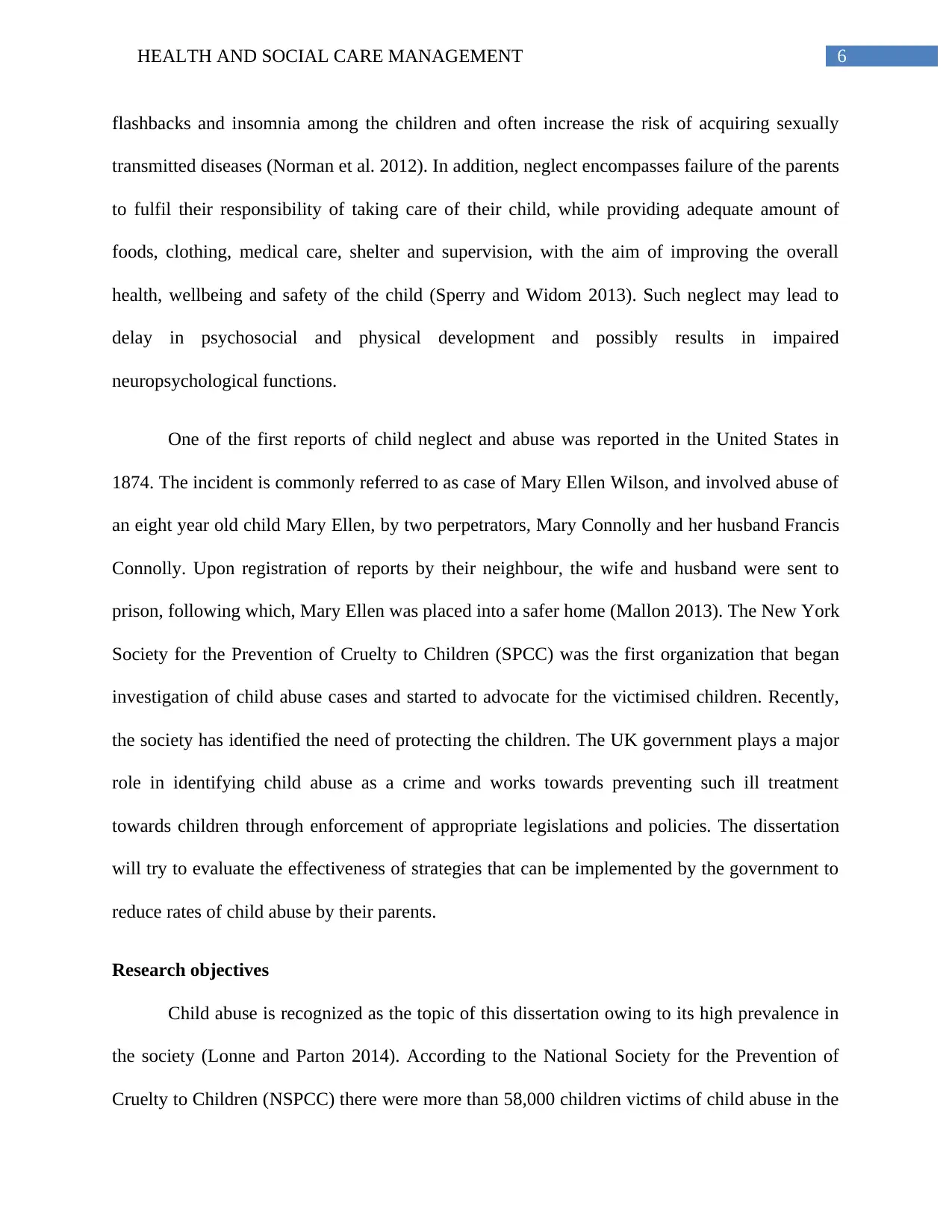
6HEALTH AND SOCIAL CARE MANAGEMENT
flashbacks and insomnia among the children and often increase the risk of acquiring sexually
transmitted diseases (Norman et al. 2012). In addition, neglect encompasses failure of the parents
to fulfil their responsibility of taking care of their child, while providing adequate amount of
foods, clothing, medical care, shelter and supervision, with the aim of improving the overall
health, wellbeing and safety of the child (Sperry and Widom 2013). Such neglect may lead to
delay in psychosocial and physical development and possibly results in impaired
neuropsychological functions.
One of the first reports of child neglect and abuse was reported in the United States in
1874. The incident is commonly referred to as case of Mary Ellen Wilson, and involved abuse of
an eight year old child Mary Ellen, by two perpetrators, Mary Connolly and her husband Francis
Connolly. Upon registration of reports by their neighbour, the wife and husband were sent to
prison, following which, Mary Ellen was placed into a safer home (Mallon 2013). The New York
Society for the Prevention of Cruelty to Children (SPCC) was the first organization that began
investigation of child abuse cases and started to advocate for the victimised children. Recently,
the society has identified the need of protecting the children. The UK government plays a major
role in identifying child abuse as a crime and works towards preventing such ill treatment
towards children through enforcement of appropriate legislations and policies. The dissertation
will try to evaluate the effectiveness of strategies that can be implemented by the government to
reduce rates of child abuse by their parents.
Research objectives
Child abuse is recognized as the topic of this dissertation owing to its high prevalence in
the society (Lonne and Parton 2014). According to the National Society for the Prevention of
Cruelty to Children (NSPCC) there were more than 58,000 children victims of child abuse in the
flashbacks and insomnia among the children and often increase the risk of acquiring sexually
transmitted diseases (Norman et al. 2012). In addition, neglect encompasses failure of the parents
to fulfil their responsibility of taking care of their child, while providing adequate amount of
foods, clothing, medical care, shelter and supervision, with the aim of improving the overall
health, wellbeing and safety of the child (Sperry and Widom 2013). Such neglect may lead to
delay in psychosocial and physical development and possibly results in impaired
neuropsychological functions.
One of the first reports of child neglect and abuse was reported in the United States in
1874. The incident is commonly referred to as case of Mary Ellen Wilson, and involved abuse of
an eight year old child Mary Ellen, by two perpetrators, Mary Connolly and her husband Francis
Connolly. Upon registration of reports by their neighbour, the wife and husband were sent to
prison, following which, Mary Ellen was placed into a safer home (Mallon 2013). The New York
Society for the Prevention of Cruelty to Children (SPCC) was the first organization that began
investigation of child abuse cases and started to advocate for the victimised children. Recently,
the society has identified the need of protecting the children. The UK government plays a major
role in identifying child abuse as a crime and works towards preventing such ill treatment
towards children through enforcement of appropriate legislations and policies. The dissertation
will try to evaluate the effectiveness of strategies that can be implemented by the government to
reduce rates of child abuse by their parents.
Research objectives
Child abuse is recognized as the topic of this dissertation owing to its high prevalence in
the society (Lonne and Parton 2014). According to the National Society for the Prevention of
Cruelty to Children (NSPCC) there were more than 58,000 children victims of child abuse in the
Paraphrase This Document
Need a fresh take? Get an instant paraphrase of this document with our AI Paraphraser
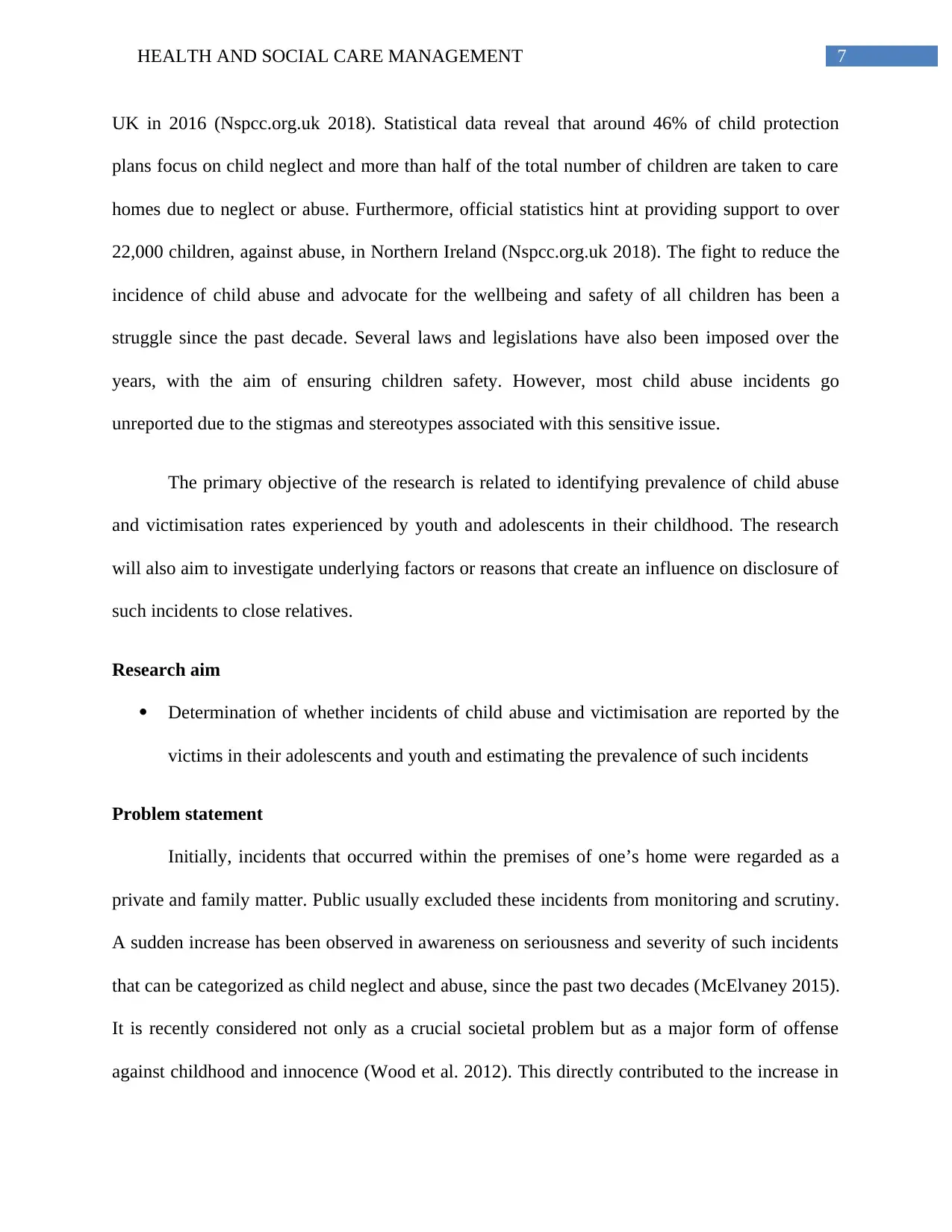
7HEALTH AND SOCIAL CARE MANAGEMENT
UK in 2016 (Nspcc.org.uk 2018). Statistical data reveal that around 46% of child protection
plans focus on child neglect and more than half of the total number of children are taken to care
homes due to neglect or abuse. Furthermore, official statistics hint at providing support to over
22,000 children, against abuse, in Northern Ireland (Nspcc.org.uk 2018). The fight to reduce the
incidence of child abuse and advocate for the wellbeing and safety of all children has been a
struggle since the past decade. Several laws and legislations have also been imposed over the
years, with the aim of ensuring children safety. However, most child abuse incidents go
unreported due to the stigmas and stereotypes associated with this sensitive issue.
The primary objective of the research is related to identifying prevalence of child abuse
and victimisation rates experienced by youth and adolescents in their childhood. The research
will also aim to investigate underlying factors or reasons that create an influence on disclosure of
such incidents to close relatives.
Research aim
Determination of whether incidents of child abuse and victimisation are reported by the
victims in their adolescents and youth and estimating the prevalence of such incidents
Problem statement
Initially, incidents that occurred within the premises of one’s home were regarded as a
private and family matter. Public usually excluded these incidents from monitoring and scrutiny.
A sudden increase has been observed in awareness on seriousness and severity of such incidents
that can be categorized as child neglect and abuse, since the past two decades (McElvaney 2015).
It is recently considered not only as a crucial societal problem but as a major form of offense
against childhood and innocence (Wood et al. 2012). This directly contributed to the increase in
UK in 2016 (Nspcc.org.uk 2018). Statistical data reveal that around 46% of child protection
plans focus on child neglect and more than half of the total number of children are taken to care
homes due to neglect or abuse. Furthermore, official statistics hint at providing support to over
22,000 children, against abuse, in Northern Ireland (Nspcc.org.uk 2018). The fight to reduce the
incidence of child abuse and advocate for the wellbeing and safety of all children has been a
struggle since the past decade. Several laws and legislations have also been imposed over the
years, with the aim of ensuring children safety. However, most child abuse incidents go
unreported due to the stigmas and stereotypes associated with this sensitive issue.
The primary objective of the research is related to identifying prevalence of child abuse
and victimisation rates experienced by youth and adolescents in their childhood. The research
will also aim to investigate underlying factors or reasons that create an influence on disclosure of
such incidents to close relatives.
Research aim
Determination of whether incidents of child abuse and victimisation are reported by the
victims in their adolescents and youth and estimating the prevalence of such incidents
Problem statement
Initially, incidents that occurred within the premises of one’s home were regarded as a
private and family matter. Public usually excluded these incidents from monitoring and scrutiny.
A sudden increase has been observed in awareness on seriousness and severity of such incidents
that can be categorized as child neglect and abuse, since the past two decades (McElvaney 2015).
It is recently considered not only as a crucial societal problem but as a major form of offense
against childhood and innocence (Wood et al. 2012). This directly contributed to the increase in
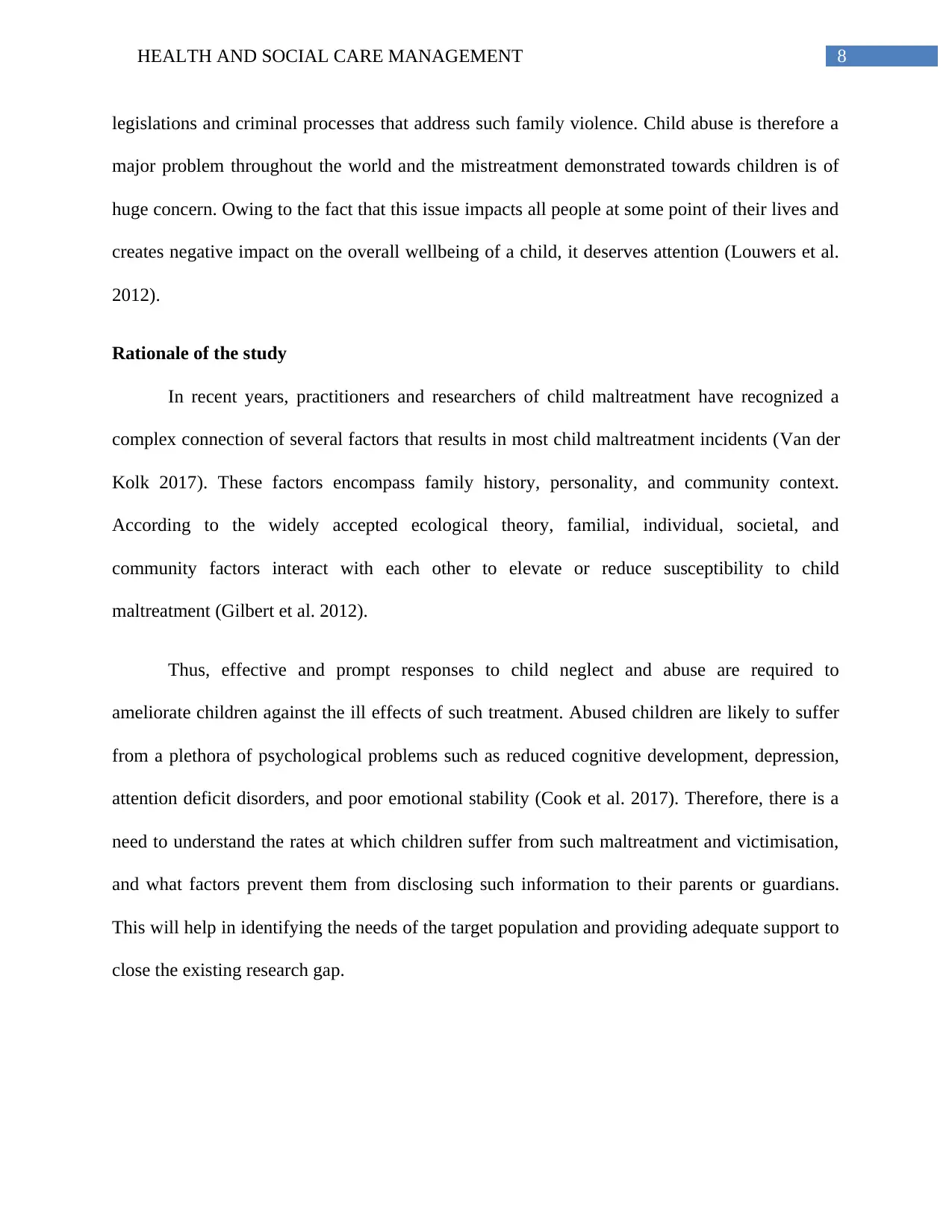
8HEALTH AND SOCIAL CARE MANAGEMENT
legislations and criminal processes that address such family violence. Child abuse is therefore a
major problem throughout the world and the mistreatment demonstrated towards children is of
huge concern. Owing to the fact that this issue impacts all people at some point of their lives and
creates negative impact on the overall wellbeing of a child, it deserves attention (Louwers et al.
2012).
Rationale of the study
In recent years, practitioners and researchers of child maltreatment have recognized a
complex connection of several factors that results in most child maltreatment incidents (Van der
Kolk 2017). These factors encompass family history, personality, and community context.
According to the widely accepted ecological theory, familial, individual, societal, and
community factors interact with each other to elevate or reduce susceptibility to child
maltreatment (Gilbert et al. 2012).
Thus, effective and prompt responses to child neglect and abuse are required to
ameliorate children against the ill effects of such treatment. Abused children are likely to suffer
from a plethora of psychological problems such as reduced cognitive development, depression,
attention deficit disorders, and poor emotional stability (Cook et al. 2017). Therefore, there is a
need to understand the rates at which children suffer from such maltreatment and victimisation,
and what factors prevent them from disclosing such information to their parents or guardians.
This will help in identifying the needs of the target population and providing adequate support to
close the existing research gap.
legislations and criminal processes that address such family violence. Child abuse is therefore a
major problem throughout the world and the mistreatment demonstrated towards children is of
huge concern. Owing to the fact that this issue impacts all people at some point of their lives and
creates negative impact on the overall wellbeing of a child, it deserves attention (Louwers et al.
2012).
Rationale of the study
In recent years, practitioners and researchers of child maltreatment have recognized a
complex connection of several factors that results in most child maltreatment incidents (Van der
Kolk 2017). These factors encompass family history, personality, and community context.
According to the widely accepted ecological theory, familial, individual, societal, and
community factors interact with each other to elevate or reduce susceptibility to child
maltreatment (Gilbert et al. 2012).
Thus, effective and prompt responses to child neglect and abuse are required to
ameliorate children against the ill effects of such treatment. Abused children are likely to suffer
from a plethora of psychological problems such as reduced cognitive development, depression,
attention deficit disorders, and poor emotional stability (Cook et al. 2017). Therefore, there is a
need to understand the rates at which children suffer from such maltreatment and victimisation,
and what factors prevent them from disclosing such information to their parents or guardians.
This will help in identifying the needs of the target population and providing adequate support to
close the existing research gap.
⊘ This is a preview!⊘
Do you want full access?
Subscribe today to unlock all pages.

Trusted by 1+ million students worldwide
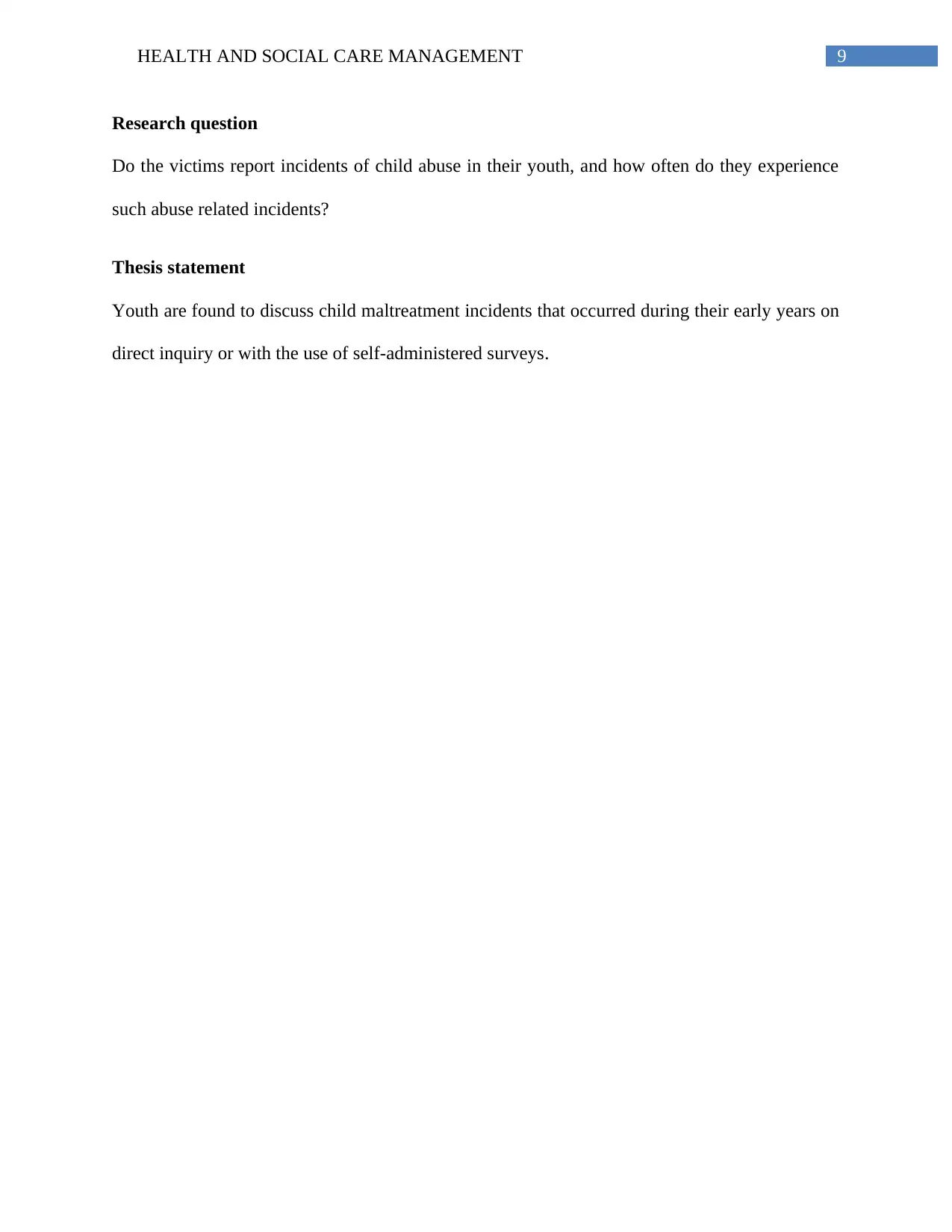
9HEALTH AND SOCIAL CARE MANAGEMENT
Research question
Do the victims report incidents of child abuse in their youth, and how often do they experience
such abuse related incidents?
Thesis statement
Youth are found to discuss child maltreatment incidents that occurred during their early years on
direct inquiry or with the use of self-administered surveys.
Research question
Do the victims report incidents of child abuse in their youth, and how often do they experience
such abuse related incidents?
Thesis statement
Youth are found to discuss child maltreatment incidents that occurred during their early years on
direct inquiry or with the use of self-administered surveys.
Paraphrase This Document
Need a fresh take? Get an instant paraphrase of this document with our AI Paraphraser

10HEALTH AND SOCIAL CARE MANAGEMENT
Chapter 2: Literature Review
Literature review refers to texts of scholarly papers that include current knowledge,
which encompasses methodological and theoretical data, in addition to substantial findings. In
other words, it acts as secondary source of information and form the foundation of academic
research (Machi and McEvoy 2016). Conducting a literature review presented findings that
provided context for the research objectives. It involved an exhaustive search of 3 online
databases namely, CINAHL, MEDLINE and PubMed. Inclusion criteria contained articles that
were published in English and not prior to 2012. Abstracts, unpublished manuscripts and articles
published in other languages, before 2012 were not included in the search. The search was
conducted using several keywords such as, “child”, “children”, “infants”, “abuse”, “neglect”,
“maltreatment”, “parents”, “elders”, “adults”, “caregivers”, “physical”, “sexual”, “emotional”,
“mental”, “harm”, “injuries”, “disclosure”, “reveal”, “prevalence”, “self-reports”, “laws”,
“policies”. The search was further narrowed using boolean operators, namely, ‘AND’, ‘OR’, and
‘NOT’. Use of these boolean operators helped in excluding articles that were not relevant to the
research objective.
According to research studies, degree of reported family violence that results in child
abuse is quite large and is most likely attributed to several years of improper socialization. Child
abuse tolerance by one generation forces it upon the next (Sperry and Widom 2013). Barbara
Lowenthal identified several signs and symptoms of physical and emotional abuse an article
named, ‘Educational Implications of Child Abuse’. She confirmed presence of cuts, bites, welts,
fractures, and burns as signs of physical abuse upon a child (Goldman and Bode 2012). Presence
of any injury that is inconsistent with the nature of the sign or reports of such injuries made by a
Chapter 2: Literature Review
Literature review refers to texts of scholarly papers that include current knowledge,
which encompasses methodological and theoretical data, in addition to substantial findings. In
other words, it acts as secondary source of information and form the foundation of academic
research (Machi and McEvoy 2016). Conducting a literature review presented findings that
provided context for the research objectives. It involved an exhaustive search of 3 online
databases namely, CINAHL, MEDLINE and PubMed. Inclusion criteria contained articles that
were published in English and not prior to 2012. Abstracts, unpublished manuscripts and articles
published in other languages, before 2012 were not included in the search. The search was
conducted using several keywords such as, “child”, “children”, “infants”, “abuse”, “neglect”,
“maltreatment”, “parents”, “elders”, “adults”, “caregivers”, “physical”, “sexual”, “emotional”,
“mental”, “harm”, “injuries”, “disclosure”, “reveal”, “prevalence”, “self-reports”, “laws”,
“policies”. The search was further narrowed using boolean operators, namely, ‘AND’, ‘OR’, and
‘NOT’. Use of these boolean operators helped in excluding articles that were not relevant to the
research objective.
According to research studies, degree of reported family violence that results in child
abuse is quite large and is most likely attributed to several years of improper socialization. Child
abuse tolerance by one generation forces it upon the next (Sperry and Widom 2013). Barbara
Lowenthal identified several signs and symptoms of physical and emotional abuse an article
named, ‘Educational Implications of Child Abuse’. She confirmed presence of cuts, bites, welts,
fractures, and burns as signs of physical abuse upon a child (Goldman and Bode 2012). Presence
of any injury that is inconsistent with the nature of the sign or reports of such injuries made by a
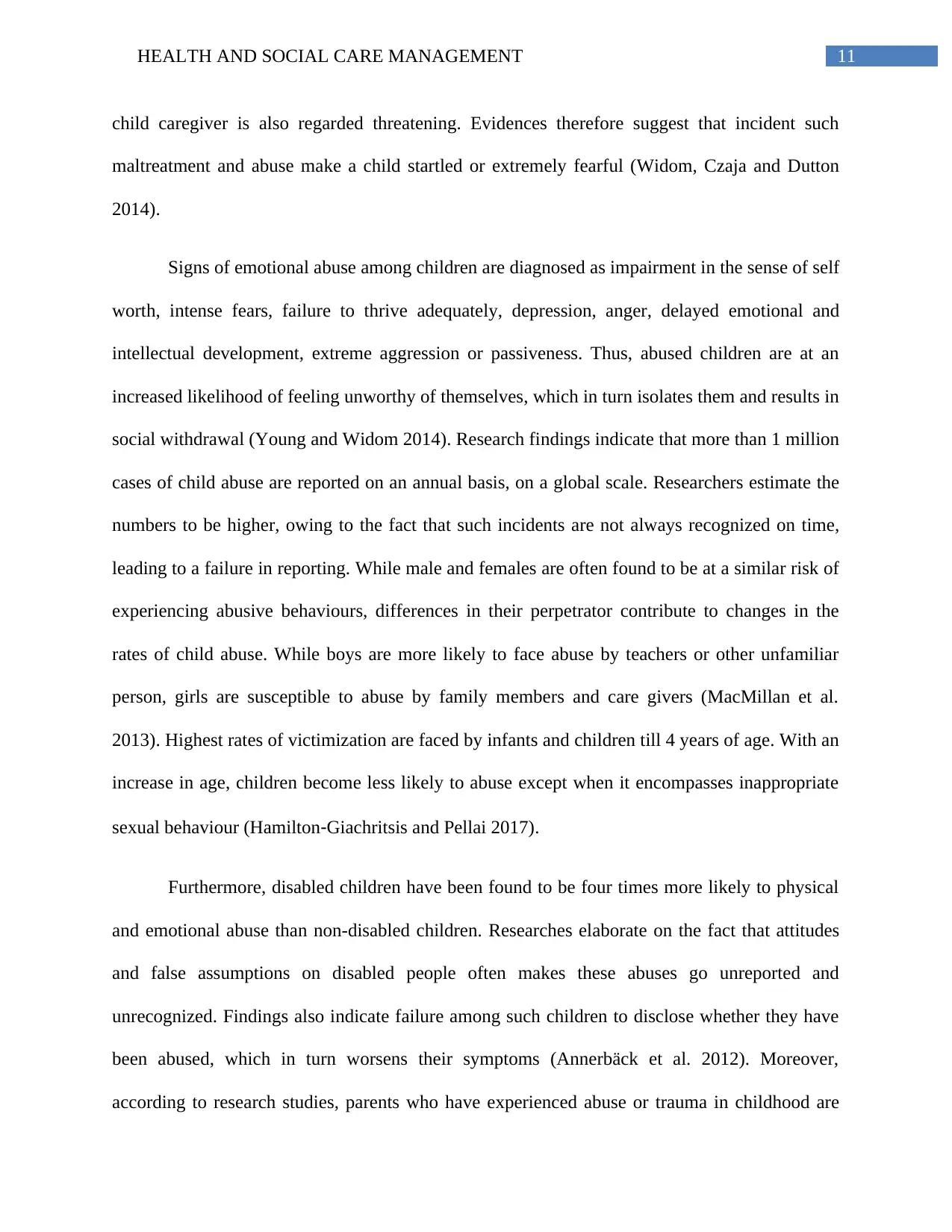
11HEALTH AND SOCIAL CARE MANAGEMENT
child caregiver is also regarded threatening. Evidences therefore suggest that incident such
maltreatment and abuse make a child startled or extremely fearful (Widom, Czaja and Dutton
2014).
Signs of emotional abuse among children are diagnosed as impairment in the sense of self
worth, intense fears, failure to thrive adequately, depression, anger, delayed emotional and
intellectual development, extreme aggression or passiveness. Thus, abused children are at an
increased likelihood of feeling unworthy of themselves, which in turn isolates them and results in
social withdrawal (Young and Widom 2014). Research findings indicate that more than 1 million
cases of child abuse are reported on an annual basis, on a global scale. Researchers estimate the
numbers to be higher, owing to the fact that such incidents are not always recognized on time,
leading to a failure in reporting. While male and females are often found to be at a similar risk of
experiencing abusive behaviours, differences in their perpetrator contribute to changes in the
rates of child abuse. While boys are more likely to face abuse by teachers or other unfamiliar
person, girls are susceptible to abuse by family members and care givers (MacMillan et al.
2013). Highest rates of victimization are faced by infants and children till 4 years of age. With an
increase in age, children become less likely to abuse except when it encompasses inappropriate
sexual behaviour (Hamilton‐Giachritsis and Pellai 2017).
Furthermore, disabled children have been found to be four times more likely to physical
and emotional abuse than non-disabled children. Researches elaborate on the fact that attitudes
and false assumptions on disabled people often makes these abuses go unreported and
unrecognized. Findings also indicate failure among such children to disclose whether they have
been abused, which in turn worsens their symptoms (Annerbäck et al. 2012). Moreover,
according to research studies, parents who have experienced abuse or trauma in childhood are
child caregiver is also regarded threatening. Evidences therefore suggest that incident such
maltreatment and abuse make a child startled or extremely fearful (Widom, Czaja and Dutton
2014).
Signs of emotional abuse among children are diagnosed as impairment in the sense of self
worth, intense fears, failure to thrive adequately, depression, anger, delayed emotional and
intellectual development, extreme aggression or passiveness. Thus, abused children are at an
increased likelihood of feeling unworthy of themselves, which in turn isolates them and results in
social withdrawal (Young and Widom 2014). Research findings indicate that more than 1 million
cases of child abuse are reported on an annual basis, on a global scale. Researchers estimate the
numbers to be higher, owing to the fact that such incidents are not always recognized on time,
leading to a failure in reporting. While male and females are often found to be at a similar risk of
experiencing abusive behaviours, differences in their perpetrator contribute to changes in the
rates of child abuse. While boys are more likely to face abuse by teachers or other unfamiliar
person, girls are susceptible to abuse by family members and care givers (MacMillan et al.
2013). Highest rates of victimization are faced by infants and children till 4 years of age. With an
increase in age, children become less likely to abuse except when it encompasses inappropriate
sexual behaviour (Hamilton‐Giachritsis and Pellai 2017).
Furthermore, disabled children have been found to be four times more likely to physical
and emotional abuse than non-disabled children. Researches elaborate on the fact that attitudes
and false assumptions on disabled people often makes these abuses go unreported and
unrecognized. Findings also indicate failure among such children to disclose whether they have
been abused, which in turn worsens their symptoms (Annerbäck et al. 2012). Moreover,
according to research studies, parents who have experienced abuse or trauma in childhood are
⊘ This is a preview!⊘
Do you want full access?
Subscribe today to unlock all pages.

Trusted by 1+ million students worldwide
1 out of 65
Related Documents
Your All-in-One AI-Powered Toolkit for Academic Success.
+13062052269
info@desklib.com
Available 24*7 on WhatsApp / Email
![[object Object]](/_next/static/media/star-bottom.7253800d.svg)
Unlock your academic potential
Copyright © 2020–2025 A2Z Services. All Rights Reserved. Developed and managed by ZUCOL.




